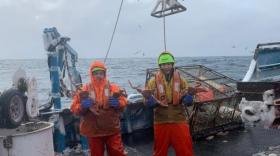In January, the 20 villages that are members of CVRF purchased almost 2% of the snow crab quota in the Bering Sea.
“We use the word quota to describe that permission to catch fish, or the harvesting rights,” said Eric Deakin, CVRF’s CEO. CVRF is one of several groups of communities along the Bering Sea coast that get a share of fisheries from federal waters, known as the “Community Development Quota.” Deakin said that the CVRF fleet had a strong crabbing season last winter, and caught about $3 million worth of snow crab.
But in October, the Alaska Department of Fish and Game announced some bad news. Next season’s allowable snow crab harvest would be cut by almost 90% due to a crash in the snow crab population.
”Ouch," Deakin said was his reaction. "Before we did the deal in 2020, the projections were really high that the crab was headed up. And this was a total surprise.”
Scientists were surprised too.
“We have seen crashes occasionally in other crab stocks. But this is not something that we expected to see in the snow crab stock for any reason,” said Katie Palof, a state biologist who also advises the North Pacific Fishery Management Council.
Part of the reason the crash was so unexpected is because biologists hadn’t seen what the snow crab population numbers were since 2019. There were no surveys last year.
“Without having that 2020 data point because of the pandemic, it's hard to know between 2019 and when the trawl survey occurred in 2021, as to when that kind of dramatic crash in snow crab happened,” Palof said.
Palof said that biologists don’t know for certain what caused the crash in snow crab numbers. A disease could have spread. It could be due to increased predation. But she said that biologists’ main hypothesis is that the mass death of snow crabs had something to do with increasing temperatures in the Bering Sea.
“In general, organisms, when the temperature increases, they need more food. And so therefore, potentially, there could be more competition for food,” Palof said. “We know that, you know, temperature does affect crab growth, food availability, overall ecosystem in general.”
Some scientists believe climate change could also be causing salmon numbers in Western Alaska to decline.
CVRF communities also purchased king crab quota earlier this year. The population of king crab has been depressed for years. Scientists believe that’s possibly due to climate change as well.
Without knowing exactly what caused so many snow crabs to disappear, Palof said that it’s unclear whether the population will rebound or remain depressed. But Deakin is optimistic about crab numbers and their member villages’ recent purchase of crab quota.
“We're long term investors. It is a shame that those assets won't be putting off any cash next year, and maybe the year after, but it will come back. We're confident crab stocks will recover,” Deakin said.
He said that villages within CVRF don’t have to worry about a few years of unprofitability. Although CVRF villages purchased the crab quota, valued at around $35 million, Deakin said that CVRF guaranteed the loan using its CDQ resources.
“We'd be on the hook to write that check for the guarantee that we made to the bank, not the villages. So they put no money down to get the loans, and they can't lose money in the program,” Deakin said.
Deakin said that CVRF has tens of millions of dollars in the bank from good fishing years to cover shortfalls like this one.





